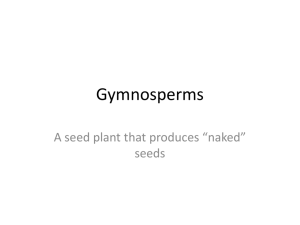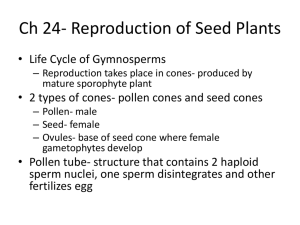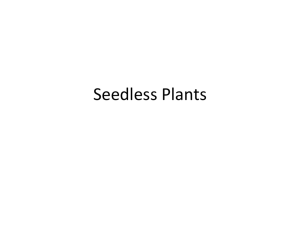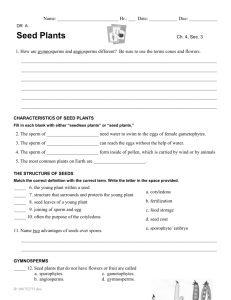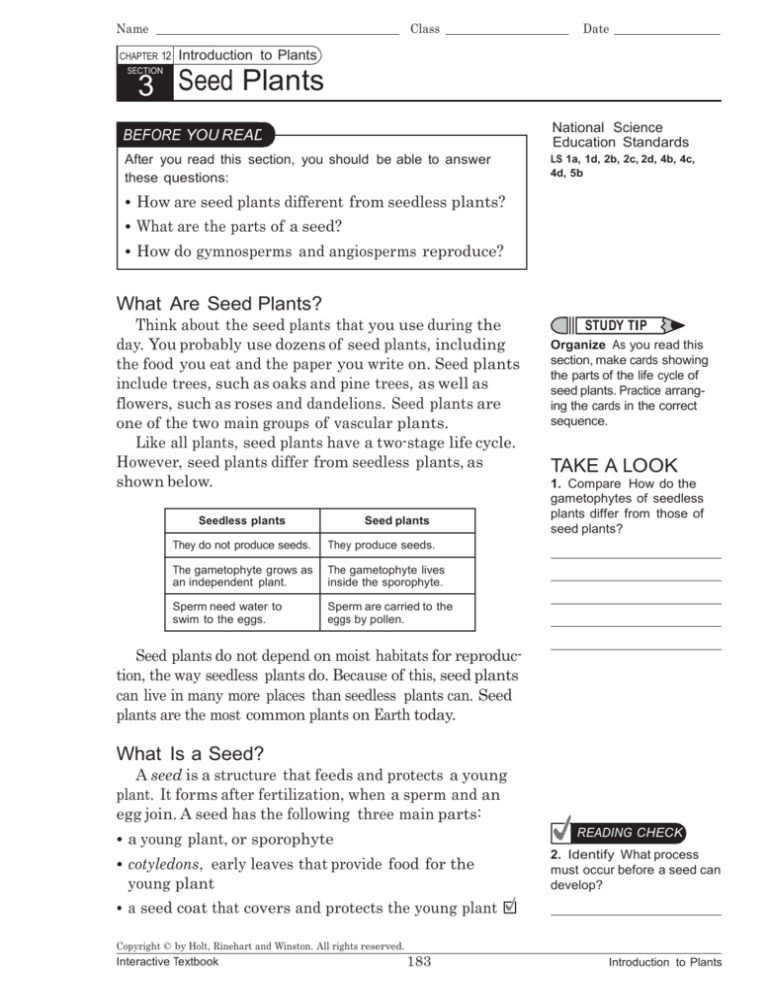
Name
CHAPTER 12
Class
Date
Introduction to Plants
SECTION
3 Seed Plants
BEFORE YOU READ
National Science
Education Standards
After you read this section, you should be able to answer
these questions:
LS 1a, 1d, 2b, 2c, 2d, 4b, 4c,
4d, 5b
• How are seed plants different from seedless plants?
• What are the parts of a seed?
• How do gymnosperms and angiosperms reproduce?
What Are Seed Plants?
Think about the seed plants that you use during the
day. You probably use dozens of seed plants, including
the food you eat and the paper you write on. Seed plants
include trees, such as oaks and pine trees, as well as
flowers, such as roses and dandelions. Seed plants are
one of the two main groups of vascular plants.
Like all plants, seed plants have a two-stage life cycle.
However, seed plants differ from seedless plants, as
shown below.
Seedless plants
Seed plants
They do not produce seeds.
They produce seeds.
The gametophyte grows as
an independent plant.
The gametophyte lives
inside the sporophyte.
Sperm need water to
swim to the eggs.
Sperm are carried to the
eggs by pollen.
STUDY TIP
Organize As you read this
section, make cards showing
the parts of the life cycle of
seed plants. Practice arranging the cards in the correct
sequence.
TAKE A LOOK
1. Compare How do the
gametophytes of seedless
plants differ from those of
seed plants?
Seed plants do not depend on moist habitats for reproduction, the way seedless plants do. Because of this, seed plants
can live in many more places than seedless plants can. Seed
plants are the most common plants on Earth today.
What Is a Seed?
A seed is a structure that feeds and protects a young
plant. It forms after fertilization, when a sperm and an
egg join. A seed has the following three main parts:
• a young plant, or sporophyte
• cotyledons, early leaves that provide food for the
young plant
READING CHECK
2. Identify What process
must occur before a seed can
develop?
• a seed coat that covers and protects the young plant
Copyright © by Holt, Rinehart and Winston. All rights reserved.
Interactive Textbook
183
Introduction to Plants
Name
SECTION 3
Class
Date
Seed Plants continued
A seed contains stored
food and a young
plant, or sporophyte.
A seed is surrounded
and protected by a
seed coat.
TAKE A LOOK
3. Label Label the parts of a
seed with these terms: young
plant, seed coat, cotyledon.
ADVANTAGES OF HAVING SEEDS
LS 5b Biological evolution
accounts for the diversity of
species developed through
gradual processes over many
generations. Species acquire many
of their unique characteristics
through biological adaptation,
which involves the selection of
naturally occurring variations in
populations. Biological adaptations include changes in structures,
behaviors, or physiology
that enhance survival and
reproductive success in a
particular environment.
Seeds have some advantages over spores. For example,
when the young plant inside a seed begins to grow, it uses
the food stored in the seed. In contrast, the spores of
seedless plants don’t have stored food to help a new plant
grow. Therefore, they will live only if they start growing
when and where there are enough resources available.
Another advantage is that seeds can be spread by animals. The spores of seedless plants are usually spread by
wind. Animals often spread seeds more efficiently than
the wind spreads spores. Therefore, seeds that are spread
by animals are more likely to find a good place to grow.
Word Help: diversity
variety
What Kinds of Plants Have Seeds?
Word Help: process
a set of steps, events, or
changes
Seed plants are divided into two main groups:
gymnosperms and angiosperms. Gymnosperms are nonflowering plants, and angiosperms are flowering plants.
Word Help: survival
the continuing to live or
exist
GYMNOSPERMS
STANDARDS CHECK
4. Identify What are two
advantages seeds have
over spores?
Gymnosperms are seed plants that do not have flowers or fruits. They include plants such as pine trees and
redwood trees. Many gymnosperms are evergreen, which
means that they keep their leaves all year. Gymnosperm
seeds usually develop in a cone, such as a pine cone.
Pine cone
Seeds
Copyright © by Holt, Rinehart and Winston. All rights reserved.
Interactive Textbook
184
Introduction to Plants
Name
Class
Date
Seed Plants continued
SECTION 3
REPRODUCTION IN GYMNOSPERMS
The most well-known gymnosperms are the conifers.
Conifers are evergreen trees and shrubs, such as pines,
spruces, and firs, that make cones to reproduce. They
have male cones and female cones. Spores in male cones
develop into male gametophytes, and spores in female
cones develop into female gametophytes. The gametophytes produce sperm and eggs.
A pollen grain contains the tiny male gametophyte.
The wind carries pollen from the male cones to the
female cones. This movement of pollen to the female
cones is called pollination. Pollination is part of sexual
reproduction in plants.
After pollination, sperm fertilize the eggs in the female
cones. A fertilized egg develops into a new sporophyte
inside a seed. Eventually, the seeds fall from the cone. If
the conditions are right, the seeds will grow into plants.
READING CHECK
5. Explain How is
gymnosperm pollen carried
from one plant to another?
The Life Cycle of a Pine Tree
Gametophyte
Fertilized egg
c Sperm and
Egg
eggs are
produced in
the cones.
Female cone
(cutaway view)
Pollen
Male cone
(cutaway view)
d Wind carries pollen
to the egg. A sperm
from a pollen grain
fertilizes the egg.
b Spores are
produced.
They grow into
gametophytes.
Male cones
TAKE A LOOK
6. Explain Does this picture
show an example of sexual
or asexual reproduction?
Explain.
Seed
a The seed contains a young
Female cones
Sporophyte
sporophyte, which grows
into an adult sporophyte.
IMPORTANCE OF GYMNOSPERMS
Gymnosperms are used to make many products, such as
medicines, building materials, and household products.
Some conifers produce a drug used to fight cancer. Many
trees are cut so that their wood can be used to build homes
and furniture. Pine trees make a sticky substance called
resin. Resin can be used to make soap, paint, and ink.
Copyright © by Holt, Rinehart and Winston. All rights reserved.
Interactive Textbook
185
Introduction to Plants
Name
SECTION 3
Class
Date
Seed Plants continued
What Are Angiosperms?
Math Focus
7. Calculate Percentages
More than 265,000 species of
plants have been discovered. About 235,000 of those
species are angiosperms.
What percentage of plants
are angiosperms?
Angiosperms are seed plants that produce flowers and
fruit. Maple trees, daisies, and blackberries are all examples
of angiosperms. There are more angiosperms on Earth than
any other kind of plant. They can be found in almost every
land ecosystem, including grasslands, deserts, and forests.
TWO KINDS OF ANGIOSPERMS
There are two kinds of angiosperms: monocots and dicots.
These plants are grouped based on how many cotyledons, or
seed leaves, the seeds have. Monocots have seeds with one
cotyledon. Grasses, orchids, palms, and lilies are all monocots.
Monocots
Leaves with
parallel veins
Flower
parts in
threes
One cotyledon
(seed leaf)
Bundles of
vascular tissue
are scattered.
Dicots have seeds with two cotyledons. Roses, sunflowers, peanuts, and peas are all dicots.
Dicots
Leaves with
branching veins
Flower
parts in
fours or
fives
Two cotyledons
(seed leaves)
Bundles of
vascular tissue
are in a ring.
Monocots
Dicots
flower parts in fours or fives
leaves with parallel veins
two cotyledons
TAKE A LOOK
8. Complete Fill in the table
to show the differences
between monocots and dicots.
bundles of vascular tissue scattered
Copyright © by Holt, Rinehart and Winston. All rights reserved.
Interactive Textbook
186
Introduction to Plants
Name
SECTION 3
Class
Date
Seed Plants continued
REPRODUCTION IN ANGIOSPERMS
In angiosperms, pollination takes place in flowers.
Some angiosperms depend on the wind for pollination.
Others rely on animals such as bees and birds to carry
pollen from flower to flower.
Angiosperm seeds develop inside fruits. Some fruits
and seeds, like those of a dandelion, are made to help
the wind carry them. Other fruits, such as blackberries,
attract animals that eat them. The animals drop the seeds
in new places, where they can grow into plants. Some
fruits, such as burrs, travel by sticking to animal fur.
READING CHECK
9. Identify Where do
angiosperm seeds develop?
TAKE A LOOK
Each of the fluffy structures on this dandelion is actually a fruit. Each of the
fruits contains a seed.
10. Identify How are the
fruits of this dandelion spread?
IMPORTANCE OF ANGIOSPERMS
Like many other plants, flowering plants provide food for
animals. A mouse that eats seeds and berries uses flowering
plants directly as food. An owl that eats a field mouse uses
flowering plants indirectly as food. Flowering plants can
also provide food for the animals that pollinate them.
People use flowering plants, too. Major food crops,
such as corn, wheat, and rice, come from flowering
plants. Many flowering trees, such as oak trees, can be
used for building materials. Plants such as cotton and
flax are used to make clothing and rope. Flowering plants
are also used to make medicines, rubber, and perfume oils.
Say It
Describe Think of all the
products you used today that
came from angiosperms.
Describe to the class five
items you used in some way
and what kind of angiosperm
they came from.
Copyright © by Holt, Rinehart and Winston. All rights reserved.
Interactive Textbook
187
Introduction to Plants
Name
Class
Section 3 Review
Date
NSES
LS 1a, 1d, 2b, 2c, 2d, 4b, 4c, 4d, 5b
SECTION VOCABULARY
pollen the tiny granules that contain the male
gametophyte of seed plants
pollination the transfer of pollen from the
male reproductive structures to the female
reproductive structures of seed plants
1. Compare How are the gametophytes of seed plants different from the gameto-
phytes of seedless plants?
2. Describe What happens during pollination?
3. Compare Use a Venn Diagram to compare gymnosperms and angiosperms.
4. List What are the three main parts of a seed? What does each part do?
5. Identify In what structure do gymnosperm seeds usually develop?
6. Identify What two structures are unique to angiosperms?
Copyright © by Holt, Rinehart and Winston. All rights reserved.
Interactive Textbook
188
Introduction to Plants


